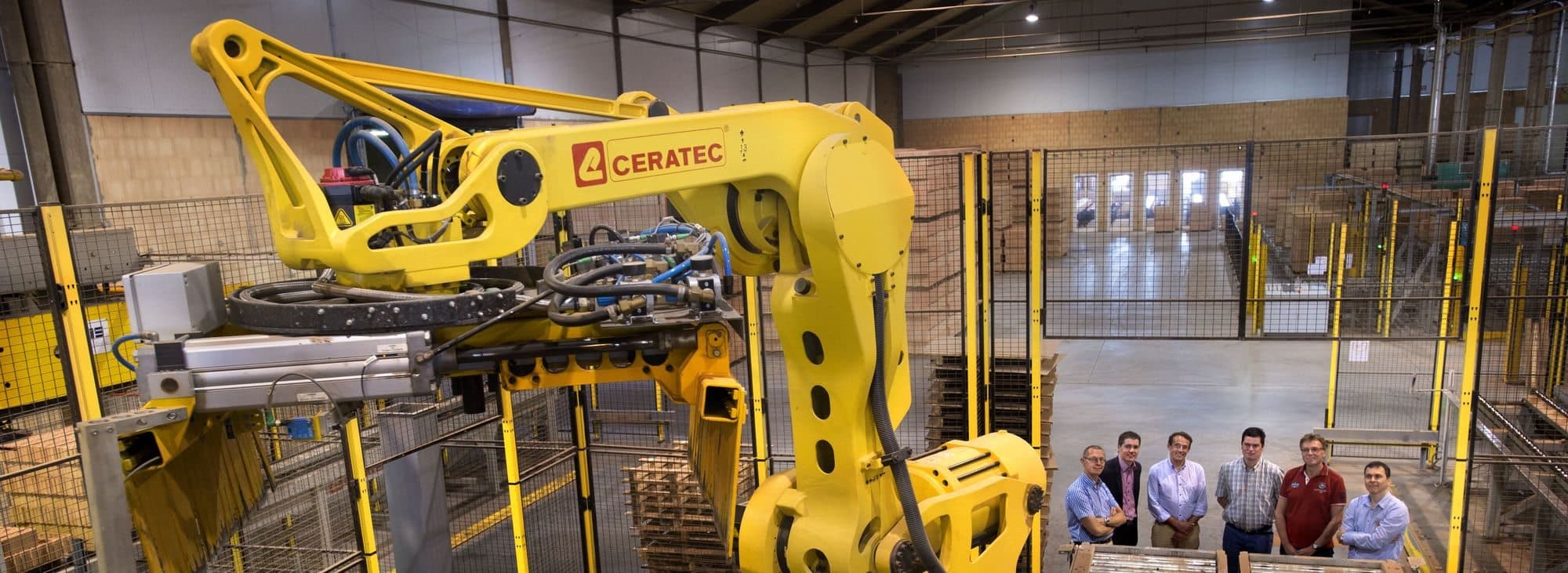Kris Maelbrancke, IT Manager: “We’ve already earned back the full cost of the project thanks to the time we’re saving on manual processing and reporting at Ploegsteert. Everything is much faster now and we avoid mistakes because manual interventions are no longer required. There’s a uniform method for data registration now too. The production, finance and sales departments all used to have their own reporting, which sometimes resulted in discrepancies in figures and could lead to worthless internal discussions, and so wasted time. We avoid all that now.”

Emissions and traceability
Ploegsteert also has to provide an increasing number of reports about the production process for legal commitments such as emissions and product traceability. It used to operate using a flat-rate calculation for its CO2 emissions, but now detailed reports are required per product type to be able to submit emissions correctly. There are also more requirements for monitoring the quality and traceability of products in the framework of BENOR and CE standards. All this demands more reporting, so automating the reporting process is very beneficial.
Francis Deboever, Production Director: “The long-term aim is still to optimise production based on the real cost. The collection of this basic data now runs in a much more structured and validated way. Each item only appears once in our reporting, for example, so mistakes and misunderstandings are eliminated. We’re already modifying the process for some production units; we can match the actual output of precast concrete beams with the theoretical output, for example. We noticed from this that too much steel wire was being used, so now we’re monitoring this on a daily basis and can intervene as required.”

Production cost in detail
The production supervisors are the main users of the reports. It gives them a good overview of the consumption of packaging and raw materials for better costing, for example. Detailed reporting on energy consumption is a next big step. Peter Schotte, Financial Director: “Over 15% of our production cost is spent on gas and electricity, but we can’t yet allocate this per product. So we know we’re going to be able to save here, but first we need the real figures to see what’s possible and what we need to prioritise. It’s very important to determine our peak consumption precisely too, and estimate day and night consumption correctly. We want to schedule our production to avoid peak moments, which will make our cash planning easier. At the moment it’s not so easy to forecast our electricity procurement in our budget correctly because of the fluctuating peak consumption.”
The production supervisors are also responsible for the correct data entry, but an increasing amount of information is automatically being read in from the machines themselves via Siemens PLCs or software for time registration. Francis Deboever: “Manual counting and tracking, such as for example counting packed pallets per product type, is gradually becoming a thing of the past. It comes out of the packaging machines automatically now. Our IT department has also ensured it’s become easier to enter data manually, so mistakes are minimised there too.”
Choice between SAP and Microsoft
To set up this BI project, Ploegsteert called on the services of Kohera. Peter Schotte: “We work with SAP for our ERP and Microsoft for most other applications within the group. So we had to choose between the two for our BI system. Microsoft was the better option for a company our size, also because the amount of work required to implement Microsoft BI is relatively limited. Power Pivot and Microsoft Excel can also be used very flexibly. Most production supervisors are already familiar with Excel and this makes it much easier to work with our new reports, in particular because of its flexibility.”
Kris Maelbrancke: “We didn’t approach anyone but Kohera because we’d already had a couple of convincing conversations with some of their other customers. From our very first contact with Kohera we felt they would really understand our operation and problems, which is of course essential in a BI project. The cost of the project was realistic and the action plan very pragmatic, so the decision was actually made quite quickly. We were also able to defend the project quite easily internally because it was clear to everyone that it would offer us very concrete benefits and really add something to the organisation.”

Standard reports for production figures
Kohera provided the data analysis and then set up a data model. When everyone could identify with the data carriers, products, categories, ingredients, averages, maximums, aggregates, etc. being used, Kohera drew up standard reports. Everyone can also create their own reports in Microsoft Excel based on the structured information in the company’s newly created data warehouse. Franky Leeuwerck, BI Consultant for Kohera: “Ploegsteert is looking at its processes in more detail than many other manufacturers. We help them convert their data into useful information so they can anticipate new developments and improve their operation.”
Ploegsteert now knows its production figures per product category – such as stones, lintels and floor systems – in quantities, weights and with use of packaging and raw materials. Another standard report shows the monthly stock levels, which can be used to explain big differences. More reports are being implemented for the deliveries of certain raw materials and energy consumption, including the surplus energy that Steenbakkerijen Ploegsteert puts back on the grid and sells. Laboratory data and quality control are additional reports that can be added later. Kris Maelbrancke: “Whenever we launch a new report, we’ve already validated first with figures from our existing sources, so we’re reducing the amount of manual reporting at Ploegsteert.”
Self maintenance after knowledge transfer
The intention is for Ploegsteert to manage the BI project and continue to expand it largely by itself. Kohera will provide training, coaching and consultancy on larger projects, and remains available via third line support. Kris Maelbrancke: “We’ll perform the smaller components, evolutions and modifications with our own IT staff. We’re not currently very familiar with the procedures and subtleties of BI, but Kohera is ensuring a good transfer of knowledge. This means we always have up-to-date reporting at Ploegsteert which we make optimal use of.”
© 2023 Kohera
Crafted by
© 2022 Kohera
Crafted by
| Cookie | Duration | Description |
|---|---|---|
| ARRAffinity | session | ARRAffinity cookie is set by Azure app service, and allows the service to choose the right instance established by a user to deliver subsequent requests made by that user. |
| ARRAffinitySameSite | session | This cookie is set by Windows Azure cloud, and is used for load balancing to make sure the visitor page requests are routed to the same server in any browsing session. |
| cookielawinfo-checkbox-advertisement | 1 year | Set by the GDPR Cookie Consent plugin, this cookie records the user consent for the cookies in the "Advertisement" category. |
| cookielawinfo-checkbox-analytics | 11 months | This cookie is set by GDPR Cookie Consent plugin. The cookie is used to store the user consent for the cookies in the category "Analytics". |
| cookielawinfo-checkbox-functional | 11 months | The cookie is set by GDPR cookie consent to record the user consent for the cookies in the category "Functional". |
| cookielawinfo-checkbox-necessary | 11 months | This cookie is set by GDPR Cookie Consent plugin. The cookies is used to store the user consent for the cookies in the category "Necessary". |
| cookielawinfo-checkbox-others | 11 months | This cookie is set by GDPR Cookie Consent plugin. The cookie is used to store the user consent for the cookies in the category "Other. |
| cookielawinfo-checkbox-performance | 11 months | This cookie is set by GDPR Cookie Consent plugin. The cookie is used to store the user consent for the cookies in the category "Performance". |
| CookieLawInfoConsent | 1 year | CookieYes sets this cookie to record the default button state of the corresponding category and the status of CCPA. It works only in coordination with the primary cookie. |
| elementor | never | The website's WordPress theme uses this cookie. It allows the website owner to implement or change the website's content in real-time. |
| viewed_cookie_policy | 11 months | The cookie is set by the GDPR Cookie Consent plugin and is used to store whether or not user has consented to the use of cookies. It does not store any personal data. |
| Cookie | Duration | Description |
|---|---|---|
| __cf_bm | 30 minutes | Cloudflare set the cookie to support Cloudflare Bot Management. |
| pll_language | 1 year | Polylang sets this cookie to remember the language the user selects when returning to the website and get the language information when unavailable in another way. |
| Cookie | Duration | Description |
|---|---|---|
| _ga | 1 year 1 month 4 days | Google Analytics sets this cookie to calculate visitor, session and campaign data and track site usage for the site's analytics report. The cookie stores information anonymously and assigns a randomly generated number to recognise unique visitors. |
| _ga_* | 1 year 1 month 4 days | Google Analytics sets this cookie to store and count page views. |
| _gat_gtag_UA_* | 1 minute | Google Analytics sets this cookie to store a unique user ID. |
| _gid | 1 day | Google Analytics sets this cookie to store information on how visitors use a website while also creating an analytics report of the website's performance. Some of the collected data includes the number of visitors, their source, and the pages they visit anonymously. |
| ai_session | 30 minutes | This is a unique anonymous session identifier cookie set by Microsoft Application Insights software to gather statistical usage and telemetry data for apps built on the Azure cloud platform. |
| CONSENT | 2 years | YouTube sets this cookie via embedded YouTube videos and registers anonymous statistical data. |
| vuid | 1 year 1 month 4 days | Vimeo installs this cookie to collect tracking information by setting a unique ID to embed videos on the website. |
| Cookie | Duration | Description |
|---|---|---|
| ai_user | 1 year | Microsoft Azure sets this cookie as a unique user identifier cookie, enabling counting of the number of users accessing the application over time. |
| VISITOR_INFO1_LIVE | 5 months 27 days | YouTube sets this cookie to measure bandwidth, determining whether the user gets the new or old player interface. |
| YSC | session | Youtube sets this cookie to track the views of embedded videos on Youtube pages. |
| yt-remote-connected-devices | never | YouTube sets this cookie to store the user's video preferences using embedded YouTube videos. |
| yt-remote-device-id | never | YouTube sets this cookie to store the user's video preferences using embedded YouTube videos. |
| yt.innertube::nextId | never | YouTube sets this cookie to register a unique ID to store data on what videos from YouTube the user has seen. |
| yt.innertube::requests | never | YouTube sets this cookie to register a unique ID to store data on what videos from YouTube the user has seen. |
| Cookie | Duration | Description |
|---|---|---|
| WFESessionId | session | No description available. |